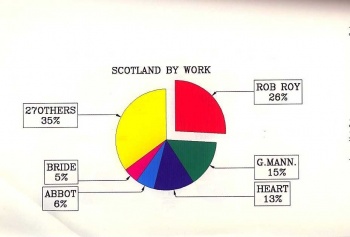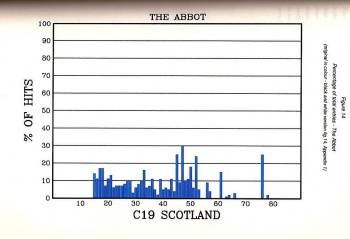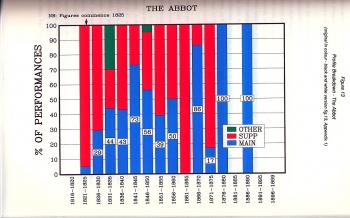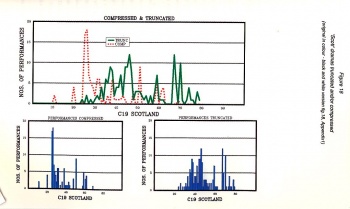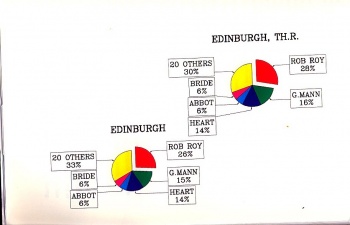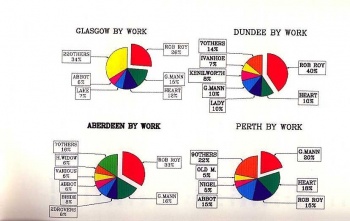Using digital methodologies to study nineteenth-century playbills
This brief paper by Dr. Barbara Bell looks at an application of digital humanities methodologies to support research into the nineteenth-century repertoire and offers up a methodology for working with theater playbills that enables previously hidden patterns of usage to emerge.[1]
‘The bills of the day’: Using Digital Methodologies to Unlock Information Hidden within the Nineteenth-century Playbill
The study of theater history has been shaped over the last thirty years by the work of a variety of scholars, whether they were concerned with the philosophical underpinnings to the work, the wider social and cultural movements within which that work sits, or whether they were engaged in practice-as-research, seeking to re-animate old texts and practices.
What has been given less attention is the capacity of advances in digital humanities to enhance the core research of the theater historian, as opposed to the presentation of results. Some of the most intriguing developments of the last decade centered around the first forays into Web 2.0, notably the Theatron3 project to transfer some of the existing Theatron computer-generated models of iconic theater spaces into Second Life where students walked their avatars around the spaces and began to create their own digital work.[2] The computer software employed by Theatron enabled the researchers to create 3D models using the available data and the resultant spaces were made available to a wider audience and in ways that would previously have been impossible. The datasets used to create models of theater spaces, whether electronically or in the form of physical hand-crafted models are taken from a variety of extant sources; physical dimensions of surviving sites (ruined/re-developed), measurements of what are believed to be similar sites, surviving documents, contemporary descriptions by those with specialist knowledge (architects, theater managers) or an “ordinary familiarity” with the public space.
Researchers of the nineteenth-century theater are more fortunate than most in that a large quantity of relevant material survives; however, it is only when one examines it more carefully that it becomes clear that, depending on the focus of study, source material may be missing entirely, fragmentary or contradictory. It now becomes even more important that the extant materials be handled in ways that enable them to provide the maximum amount of data for the researcher to interpret.
Some of the most visible materials are the playbills which survive in almost every library and archive, whether large, well-organised collections or the single folders of disparate bills, catalogued as ‘’Paper Ephemera’’ in the Local Studies Collection. However, it is when one wishes to go beyond an apt illustration, to reveal any single playbill as containing evidence of significant managerial practices or cultural trends, that one comes up against the challenge of dealing with bills in the quantity that will allow such practices and trends to be identified with any degree of confidence.
Prior study
Over the last twenty years, digital humanities efforts have put the handling of large quantities of playbills within the reach of the lone researcher, who would previously have been confined to laboriously filling out index cards and for whom the cross-indexing and focused search of materials could become extremely difficult.
H. Philip Bolton is author of a series of volumes, listing the contents of playbills featuring adaptations of works by major writers including Sir Walter Scott and Charles Dickens. These handlists were created with the invaluable assistance of the first generation of readily available PCs and laptop computers.[3] The handlists and their subsections are prefaced by Bolton’s overview of the materials; however, there is little in the way of formal analysis of the content of the bills and so much of the information they contain as a body remains locked within them.
One study, seeking to illuminate the workings of the nineteenth-century Scottish theater repertoire, particularly the unique sub-genre called “The National Drama” and the part played in it by adaptations of the works of Sir Walter Scott, provided an opportunity to develop a method for handling and analysing information coming out of a search of over 35,000 playbills.[4]
Scott’s twenty-three novels and five long poems in their stage adaptations provided a major impetus for the eventual abolition of the Theatre Patent, by gifting the burgeoning Minor theater industry with a semi-legitimate repertoire with which they could compete with the Patent Houses. Furthermore, because the invaluable dialogue could be lifted directly from the novels, audiences were able to make direct comparisons between productions. However, within Scotland they were thought to have brought about a more fundamental shift in the attitude of the general population to the theater.[5] Contemporary sources of information, reviews, memoirs, nineteenth-century histories, accepted the place of the National Drama at the heart of the Scottish repertoire and the large part that the Scott adaptations played in the rise of the National Drama; however, none thought it necessary to explain how the process worked.
Establishing methodology
The data produced by the study of a random stratified sample, comprising 3,605 entries taken from 35,000 bills, covering 30,000 nights in 280+ theaters, was intended to serve two purposes:
- To provide quantitative and positional data (Who, What, Where)
- To provide qualitative data (How, Why)
Both outcomes would sit alongside consideration of more traditional materials. Only bills featuring work taken from Scott would be subjected to close scrutiny. Initially, a sample of bills was analysed to help formulate the relevant search terms. Comparative analysis was made possible by the structures both of the nineteenth-century theater industry, changing programs every night for most of the century and peculiarly responsive to external pressures, and the playbill format that remained largely unchanged for much of the century, conducting a continual dialogue with the audiences through a shared language employing accepted theatrical jargon, popular cultural references and the manager’s skilful reading of the shifting mood of the target audience.
It was possible to establish the parameters for the study in a set of coded terms that covered quantitative items such as the name of the theater, day of the week, date and name of the play(s) concerned. These were set alongside a group of search tags that covered qualitative matters.
| Benefit | named performer has their benefit and performs named Scott role |
| Special Occasion | explanation follows e.g., Patronage |
| Combination | two or more Scott dramas appear on the same night |
| Favorite Music, Favorite Character | characters, music appears outwith the play e.g., An Address in Character by Bailie Nicol Jarvie (from Rob Roy) |
| Compressed | a larger piece is cut down but retains the outline of the full piece |
| Truncated | a piece is present with sections missing eg. Acts 1&3 |
| Favorite Scene | a single scene appears |
| Guest Artist In/Out | a named Guest Artist does or does not appear in the Scott drama |
| Run | three or more consecutive performances of the same piece. |
| Broken Run | a substantial run is broken by single nights of other work |
| Cluster | three or more different Scott pieces given within three days |
| Revival | a performance as described as such |
| Season | a period with readily identifiable parameters within which the bulk of the pieces are from Scott (NOT a normal theatrical season) |
| Remote | a tenuous connection with a Scott original eg. Life of Napoleon |
| Cross-dressing | a performer, named, takes on a cross-dressed role |
| New Costumes/scenery | specific mention is made on the bills of an investment in the setting |
| Amateur | an amateur actor appears in a named role |
| Juvenile | a juvenile performer appears prominently on the bill |
| Date Query | the date is a matter of speculation (see next in list) |
| Damaged/Part/Shaved bill | the playbill examined is incomplete in some way |
| Leads | principal actors and their roles (Folger Henderson System tag) |
| Songs | named pieces of music (Folger Henderson System tag) |
The two last tags belonged to a modified process applied to playbills collected by a nineteenth-century music publisher, William Henderson, who divided his extensive holding into four categories (Waverley [from Scott], Scottish other than Waverley, Shakespeare, Music on the British Stage). This fine collection (encompassing bills from throughout the UK and the West Indies and now held by the Folger Shakespeare Library) acted as a control, against which to assess the results of the main study.
In many respects the Special field provided some of the most intriguing information, in that it allowed identification and collection of data that illustrated, for example, the ‘value’ set on this part of the repertoire by industry practitioners and audience alike. As the appearance of the Scott adaptations brought about the rise of an identifiable genre, the Scottish National Drama, to the point where management could say “A new National Drama is in preparation” secure in the knowledge that all shared the same expectations, it was possible to plot the broadening of patronage, and the use of Scott dramas on occasions designed to appeal to the whole community, such as theater openings and charitable nights. Similarly, the pattern of Compressed and Truncated performances illustrates the extent to which popular audience knew the material. In addition, examination of the Folger Henderson Scottish other than Waverley and Waverley collections of bills, made it possible to identify those trends and practices peculiar to Scotland’s engagement with the Scott dramas, for example, in their designation as “national dramas/operas/plays.”
Analysis of the catalog
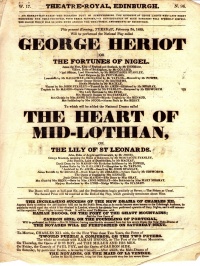
The Main Catalog Listing comprised 3,605 entries.[6] The lists, graphs, statistics and diagrams that emerged provided a unique insight into the workings of the nineteenth-century Scottish repertoire. It became clear that at the height of its popularity, works drawn from Scott appeared on the Scottish stage one night in three. They were done by ‘’every theater and company’’ from the Patent houses to the smallest travelling bands, and every audience saw largely the same Scott originals in their stage versions.
By drawing out the frequency of performance and also the variety of that performance, noting not only when Scott dramas were performed but the variety of works from which they came, the "shape" of the place within the repertoire held by this material emerged from the mass. Further, it became possible to see phases of usage having an impact on the choices being made about the pieces by theater managers.[7]
Patterns and exemplars
During the initial period of their popularity (broadly 1817-1835), the rush to adapt the latest novel before your rivals, or to produce it with particular distinction, and the undoubted financial success of the pieces, is reflected in investments in scenery, the pattern of benefits, etc., and particularly in the descriptions given to the works. This is the most constant and visible sign of the Patent/Minor struggle for legitimacy being made by the popular theater. Overall, only 7% of the Main Listing entries contain work described as “melo-drama” or “melodramatic.”
After Scott’s death in 1832, the period to around 1855 sees the consolidation of the Scott dramas place within the repertoire and the beginning of the decline in their performance at the major houses, with managers being discriminating about where they place the work, increasingly relying on “Seasons” of Scott/National dramas located around the visits of Guest Artists. The final period to 1900, featuring a split between the treatment given to the pieces by the major theaters and the popular stage, can be traced in the rise of the lengthy runs and tours of lavish revivals and re-adaptations, when the impetus to stay true to the “latest novel” no longer holds sway.
The major Scott works, in terms of numbers of performances of adaptations, were given their own treatment, identifying not only the number of “hits” from the catalog in which they figured, but also breaking that contribution down by its component parts, into appearances as a MAIN piece, a SUPPorting piece, or other activity. Therefore it can be seen, for example, that performances of material taken from The Abbot constitute around 30% of the Scott work located in the mid-1840s, whilst the second graphic reveal that those performances were primarily in a supporting role.
The Abbot
Adaptations of ‘’The Abbot’’ are particularly interesting in this respect. It is not one of Scott’s best known novels, but one section featured Mary, Queen of Scots’ escape from Loch-Leven Castle, which had an established place in Scottish popular culture as a stirring, but ultimately tragic, tale. As the graphics make clear, initially it was used primarily as a supporting piece—small scale, local interest and with a couple of good parts for the leads. Previously Schiller’s artistic but historically inaccurate ‘’Mary Stuart’’ had been the “Mary” play acceptable to the English censors, but Scott’s novel allowed for a less grandiose piece. Its uncomplicated utility, allows it to have an unbroken run of years before the Scottish public from 1825 to 1863.
The graph illustrating The Abbot pieces, divided into MAIN and SUPP works, also illustrates well the phenomenon whereby it becomes important to re-assess what constitutes worth within the overall repertoire.
…when considering management decisions, it is not always enough to say that X was a less successful play than Y because it was performed more often as a SUPPorting piece. X may have been used more often as a stop-gap in an emergency, it may feature Guest Artists or be a regular choice for Benefits or Special Occasions. X’s appearance in a supporting role on the bill, may be as a part of a ‘Scott’ Season, in which case, its perceived identity as part of a recognisable body of work, adds to its individual impact. X may, in its supporting form be a cut-down version of a popular main piece which is maintaining its connection with the audience in the interval before being revived in all its former glory. In its versatility and durability, X actually plays a more important part in the repertoire than Y which appears briefly as a main piece and is rarely seen again.[8]
Taken as a whole, the results served rather as the parch-marks left in fields by structures buried out of sight, that are only visible seen from above and which provide prompts for investigation, for the archaeologists to “drill down” into the ground for evidence, in this instance either by returning to the traditional materials to read them again with a new eye or by following new lines of enquiry.
Breakdown of data
There were some surprises. A tabular breakdown of the Scott works in order of incidence revealed that whilst the first few places were held by the expected favorites, adaptations of a Scott short-story, The Two Drovers, came in ahead of better-known works such as The Antiquary and The Lady of the Lake.[9]
| Work | Placing to 1850 | Placing 1810-1900 |
|---|---|---|
| Rob Roy | 1 | 1 |
| Guy Mannering | 2 | 2 |
| Heart of Mid-Lothian | 3 | 3 |
| The Abbot (Mary Queen of Scots) | 4 | 4 |
| Bride of Lammermoor | 5 | 5 |
| Two Drovers | 6 | 7 |
| Redgauntlet | 7 | 12 |
| St. Ronan's Well | 8 | 13 |
| Ivanhoe | 9 | 9 |
| Antiquary | 10 | 14 |
| Legend of Montrose | 11 | 11 |
| Fortunes of Nigel | 12 | 10 |
| Lady of the Lake | 13 | 6[10] |
The value placed on the works collectively became clear with the emergence of instances from theaters across the country as Scott adaptations were compressed and truncated, where the popular audiences clearly knew the material so well that managements could play “beginning at Act 2” or a favorite character’s scenes.[11] The only other material treated similarly was Shakespeare.
The data from the Main Listing was valuable in itself, sparking new searches within the traditional materials, but it also served to test the existing ideas and assumptions about the subject made on the basis of those materials.
Cross-dressing
An example of where the new source of data proved most useful came when considering cross-dressing, particularly male roles taken on by actresses. The tendency had been to see such work as akin to Madame Vestris’ displays at the Olympic; “breeches roles” providing mild titillation with sight of a well-turned leg, a matter of note on the bills and largely prompted by economic concerns. Amongst the traditional sources of information were the Glover Memoirs, serialised in the ‘’Glasgow Evening Times’’ in 1890. William Glover enjoyed a long career in the Scottish theater, was interested in its history and came from a distinguished theatrical family. His memoirs contain a fund of intriguing information and he says of an 1865 production of Rob Roy featuring a Miss Erskine in the role of Francis Osbaldiston “[T]his was the first time that ever I had seen the part of Francis played by a female – or even heard of it. Since then, for course, it has been frequently played so.”[12] Given Glover’s background it is tempting to take at face value his assessment of Scotland’s experience of the role; however, the Main Catalog Listing reveals that this was in fact a commonplace occurrence amongst the smallest groups of travelling players going to small towns and villages, occasioning no particular mention on the bills. There certainly was an economic imperative. Further analysis of the performance patterns makes it clear that at the height of their popularity every company had to perform the principal pieces from the National Repertoire and if they were to do the Scott dramas they had to perform all the music. The chances of their having even one good ballad tenor amongst the strolling companies were slim and so women played romantic male leads.
Locations
Similarly, the Edinburgh Theater Royal had, in a vain attempt to protect its financial “sheet-anchor,” sought to portray itself as the natural home of the National Drama. It is most often mentioned in connection with the genre in the literature of the day, in part because so many Scottish actors and managers trained at the Theater Royal under W.H. Murray; however, the Main Catalog revealed that other cities and theaters, legitimate and illegitimate, performed a similar spread of the core Scott adaptations.[13] The Theater Royal’s politicking had co-incidentally allowed the conventional materials to blunt and narrow the true impact of the genre throughout Scotland.
Patterns of usage
Finally, by surveying the various elements contained on the bills as a whole, it became possible to discern patterns of usage, that carried with them implied value, and that were the same for almost all of the most successful Scott originals in adaptation, as in the example below.[14]
Patterns of Usage for Major Works (On first appearance)
• Initial runs of a MAIN piece may end with one or two SUPPorting appearances. The play may then either be repeated occasionally that season as a MAIN piece or be COMPRESSED into an afterpiece.
• The play will be used for BENEFITS, first by actors with leading roles (and the Manager) and as the years pass by supporting players and finally the backstage staff, eg. Stage Managers, Ticket Checkers, whose comparative lack of public profile to attract support for their benefits argues a reliance on repertoire favourites.
• The piece will be favoured by GUEST ARTISTS either brought in to play a role, e.g., central singing roles in Rob Roy adaptations, or brought in to play their usual repertoire but adding in a national role, perhaps for a benefit, as a gesture to the local audiences.
• The play will be used for emergencies, e.g., illness forces a change of bill
• It will appear on SPECIAL OCCASIONS or receive PATRONAGE.
• The play’s REVIVAL will be greeted as a looked-for and familiar event.
• There will be regular investment in NEW SCENERY/COSTUMES or music
One category of information was abandoned in the course of the study. Originally there was a search tag ‘CATT’ for Coming Attractions, as it had been planned to chart the course of advanced publicity; however, it became clear from early on that the sheer amount of Scott work being done would render it a huge task and one that did not perhaps contribute as much to the overall focus as had first been thought.
A “complete” analysis of an individual theater’s output would be a fascinating undertaking, if sufficient bills survived to allow a clear, long-term, picture to emerge.[15] One of the most striking features of the study was the way in which it enabled the subtle, skilful, considered judgement of the nineteenth-century theater manager to emerge from the noise and bustle generated by a repertoire that operated on a changed program every night.
In this instance, the playbills for nights that did not contain material from Scott were not analyzed and so there is only the accumulated experience of the researcher to back their considered opinion that there was no other genre receiving similar treatment. Clearly, it would be fascinating to perform a similar operation to investigate other areas of the repertoire; however, it is doubtful whether the particular collision of cultural, political and economic circumstances that prompted the rise of the Scottish National Drama would be found elsewhere.
Conclusions and paths of further inquiry
Nevertheless there are some areas that spring to mind as suited to the application of a similar style of playbill analysis. The use of the title of “National Drama” was quite different beyond the borders of Scotland and a similar study of London/England would make a fascinating companion piece with perhaps much to reveal about the cultural shifts in nineteenth-century Britain. It would also be interesting to look at the repertoire offered to communities experiencing successive waves of immigration in nineteenth-century America. What materials were assumed to sit within a shared fund of cultural knowledge? What materials might be aimed at the new arrivals, as comforting reminders of a romanticised home? What materials played to the fear of the stranger within the existing community? If these communities co-existed, how did the managements manipulate the repertoire to support these different audience groups and maximise their profits?
In the nineteenth-century playbill, researchers would seem to have set before them a blend of quantitative and qualitative data designed to speak to the reader in accents of familiarity and novelty. However, if we are to be able to access this ongoing dialogue between the theater and its audience, then we must be attuned to nuances that can slip past un-noticed in a single bill. It is the application of digital humanities that allows us to open up those channels of communication, so that echoes from the past sound in our ears again.
Bibliography
Bell, Barbara A.E. “The Nineteenth Century.” In Findlay, B. (ed.) A History of Scottish Theater. Edinburgh: Polygon, 1998. pp.137-206.
Ibid. “Sir Walter Scott and the National Drama.” In: Alexander, J.H. and Hewitt, D. (eds) Scott in Carnival. Aberdeen: ASLS, 1993. pp. 459-477.
Ibid. Nineteenth-century Stage Adaptations of the Works of Sir Walter Scott on the Scottish Stage: 1810-1900. An unpublished Ph.D. thesis submitted to Glasgow University (April 1991).
Bolton, H. Philip. Dickens Dramatized. Boston: G.K. Hall, 1987.
Ibid. Scott Dramatized. London: Mansell, 1992.
Bratton, J. New Readings in Theater History. Cambridge: Cambridge University Press, 2003.
English LTSN. Theatron3 Second Life project. http://www.english.heacademy.ac.uk/explore/projects/archive/ technology/tech23.php (Accessed last March 15, 2015).
Ragussis, M. Theatrical Nation: Jews and Other Outlandish Englishmen in Georgian Britain. Philadelphia, PA: Pennsylvania University Press, 2010.
Worthen, W.B. & Holland, P. (ed.) Theorizing Practice. Basingstoke: Palgrave Macmillan, 2003.
Notes
<references>
- ↑ Barbara Bell. “Sir Walter Scott and the National Drama.” In: Alexander, J.H. and Hewitt, D. (eds) Scott in Carnival Aberdeen: ASLS. 1993. pp. 459-477. This article contains some of the illustrations that follow. The focus of that paper was on Scott and his theatrical legacy. This paper concentrates on the methodology and argues that it is applicable to a more general analysis of the C19 repertoire.
- ↑ The English Subject Centre has details of the Theatron3 Second Life project at http://www.english.heacademy.ac.uk/explore/projects/archive/technology/tech23.php Page accessed last 15/01/2015 The Theatron theatres have now been removed from Second Life and are currently seeking a new home.
- ↑ H. Philip Bolton Dickens Dramatized. (Boston, MA: G.K. Hall, 1987) and Scott Dramatized. (London: Mansell, 1992).
- ↑ Barbara Bell. "Nineteenth-century Stage Adaptations of the Works of Sir Walter Scott on the Scottish Stage: 1810-1900." An unpublished Ph.D. thesis submitted to Glasgow University, April 1991.
- ↑ See Barbara Bell “The Nineteenth Century.” In Findlay, B. (ed.) A History of Scottish Theater (Edinburgh: Polygon,1998) pp.137-206.
- ↑ The software used was Famulus77, designed for bibliographic records. The project ran on Glasgow University’s mainframe computer, an ICL3980. Today, a laptop could perform the same functions.
- ↑ As the century progressed the National Drama became woven into the fabric of Scottish theaters and the bills note Scott characters and scenes displayed on drop-cloths, walls, fitments and programmes.
- ↑ Bell (1991) p.60.
- ↑ Bell (1991) p.83
- ↑ Pieces from The Lady of the Lake, Scott’s early poem, came into their own towards the end of the nineteenth-century when a split in the approach to The National Drama appeared between the popular stage and the major houses, who favoured the Highland epic as a vehicle for long runs of lush, romanticised productions with large casts and lavish settings.
- ↑ It had been assumed that the mass of the population encountered Scott’s works through chapbooks. Further research has revealed many of the most popular chapbooks to be condensed versions of the stage adaptations. See Bell (1991) Chapter 4, pp.118-125.
- ↑ “Glover Memoirs” ‘’Glasgow Evening Times’’. 15 May 1890. p.4.
- ↑ The Main Catalog Listing contains details of over a thousand performances from Rob Roy, but they are called ‘melodramas’ on only nine occasions and seven of those nine nights involve minor theaters seeking to deflect W.H. Murray’s attentions.
- ↑ The databases were intended to continue life as a tool for researchers in the Scottish Theatre Archive, in Glasgow University Library. Unfortunately, they were accidentally destroyed during a mainframe system upgrade. Hard copies remain, but they are currently no longer searchable in the same way.
- ↑ Michael Ragussis’ study Theatrical Nation: Jews and Other Outlandish Englishmen in Georgian Britain (Philadelphia: Pennsylvania University Press, 2010) makes a persuasive case for the wider analysis of the repertoire.
